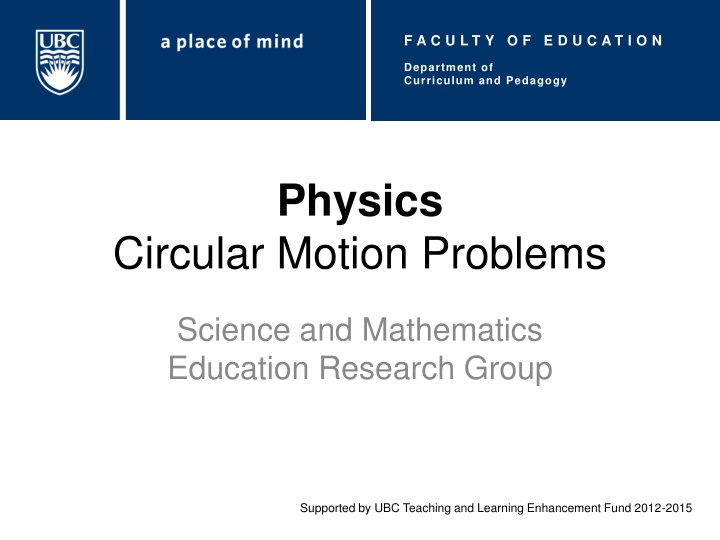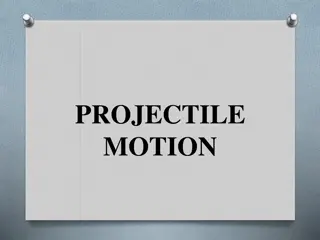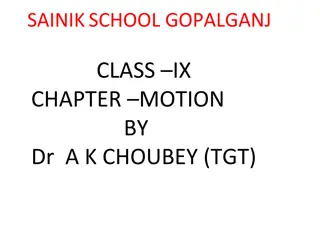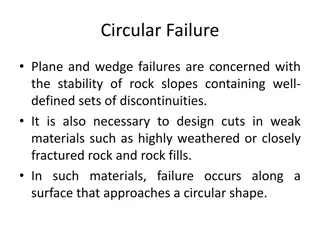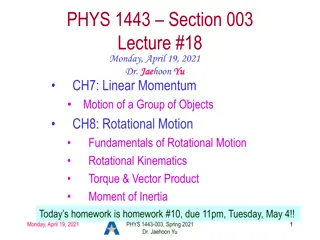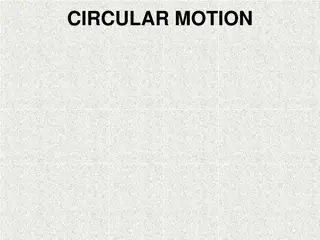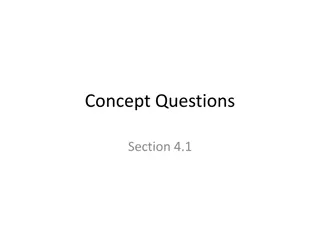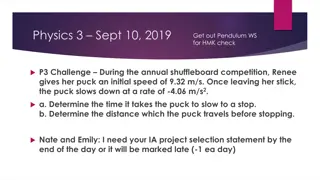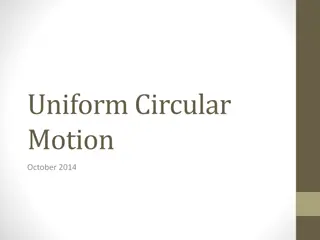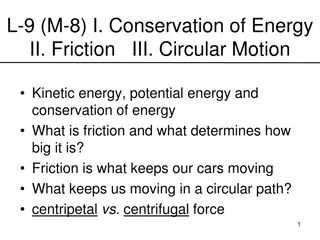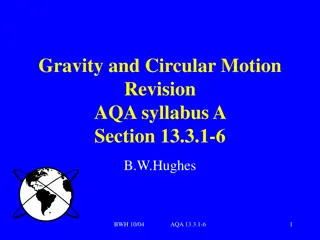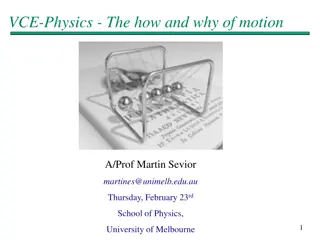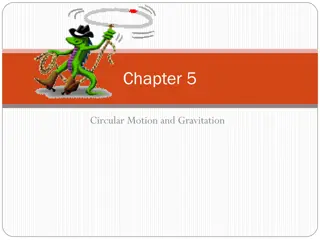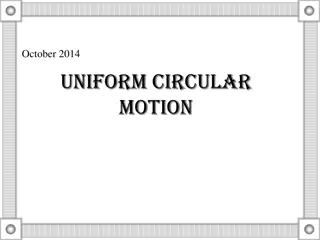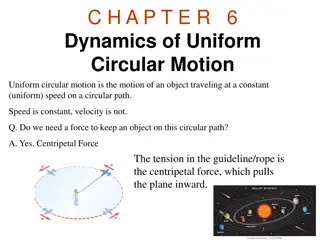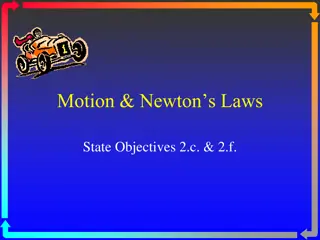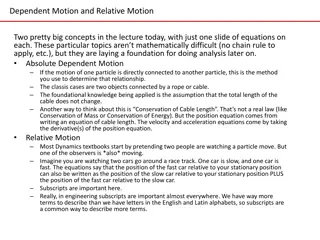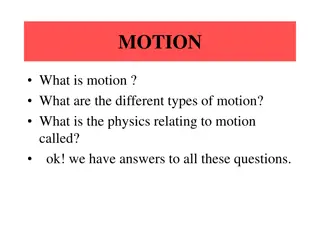Circular Motion Problems - Physics and Education Research
This content delves into circular motion problems in physics education, specifically addressing the radial acceleration of a car on a racetrack. It discusses the effects of doubling the velocity and halving the radius on radial acceleration, providing a comprehensive explanation and solution. The explanations are supported by visuals and aim to enhance understanding of this fundamental physics concept.
Download Presentation

Please find below an Image/Link to download the presentation.
The content on the website is provided AS IS for your information and personal use only. It may not be sold, licensed, or shared on other websites without obtaining consent from the author.If you encounter any issues during the download, it is possible that the publisher has removed the file from their server.
You are allowed to download the files provided on this website for personal or commercial use, subject to the condition that they are used lawfully. All files are the property of their respective owners.
The content on the website is provided AS IS for your information and personal use only. It may not be sold, licensed, or shared on other websites without obtaining consent from the author.
E N D
Presentation Transcript
FACULTY OF EDUCATION FACULTY OF EDUCATION F A C U L T Y O F E D U C A T I O N Department of Curriculum and Pedagogy Physics Circular Motion Problems Science and Mathematics Education Research Group Supported by UBC Teaching and Learning Enhancement Fund 2012-2015
Question Title Question Title Circular Motion Problems Retrieved from: http://www.wonderwhizkids.com/index.php/physics/mechanics/circular-motion
Question Title Question Title Circular Motion Problems The following questions have been compiled from a collection of questions submitted on PeerWise (https://peerwise.cs.auckland.ac.nz/) by teacher candidates as part of the EDCP 357 physics methods courses at UBC.
Question Title Question Title Circular Motion Problems I A Ferrari is traveling in a uniform circular motion around a racetrack. What happens to the radial acceleration of the car if the velocity is doubled and the radius of the circle is halved? A. It remains the same. B. It increases by a factor of 2. C. It increases by a factor of 4. D. It increases by a factor of 8. E. It decreases by a factor of 2.
Question Title Question Title Solution Answer: D Justification: The radial acceleration for a car in a uniform circular motion is: v is the velocity of the car and r is the radius of the circular track v r
Question Title Question Title Solution continued If we double the velocity, we can see that the radial acceleration, ar will be increased by a factor of 4 (velocity is squared). If we halve the radius (i.e. multiply it by ), then since it is inversely proportional to ar, the radial acceleration will increase by a factor of 2 (it will double). Therefore, ar is increased by a factor of 2 x 4 = 8 (answer D). Note: If you are driving and you approach a curve, it is important to slow down because your acceleration increases by a factor of velocity squared. The sharper the curve is (the smaller the radius of circular motion), the more acceleration you will need to be able to turn. This acceleration is caused by the force of friction between the tires and the road. The friction force keeps the car going along the curved road. Thus, when it is raining (and the force of friction is decreased), remember to slow down while turning.
Question Title Question Title Circular Motion Problems II Sonic is rolling towards a spring in order to quickly change the direction of his speed and make it around the loop. The mass of the giant blue hedgehog is 30 kg and he is rolling towards the spring at 20 m/s. The spring is massless (and therefore perfect), can compress 0.5 m and is attached to an immovable block.
Circular Motion Problems II Question Title Question Title continued You can assume that there is no friction between the ground and rolling Sonic. What is the smallest the spring constant could be in order for Sonic to roll around the 30 m loop? Remember: Treat Sonic like an indestructible point mass sliding along his trajectory. Acceleration due to gravity = 9.82 m/s2. A. Sonic already has enough kinetic energy to complete the loop therefore the value of the spring constant is irrelevant. B. The value of the minimum spring constant is 71 kN/m. C. The value of the minimum spring constant is 88 kN/m. D. The value of the minimum spring constant is 119 kN/m. E. Sonic cannot make the loop regardless of the spring constant.
Question Title Question Title Solution Answer: C Justification: This question is solved through the conservation and transfer of energy. How should you know this? The first hint is that we don't have mathematical tools as grade 12's to solve this problem any other way. The second hint is that time is not directly referenced in the problem. The third hint is that Sonic's velocity is the only factor that will determine whether he successfully makes the loop, and since his mass isn't changing, the velocity is only dependent on his kinetic energy. The first thing that comes to mind when faced with this problem should be: "What conditions must be met in order for Sonic to make the loop?"
Question Title Question Title Solution continued If we notice that the loop is a case of circular motion we can figure out the minimum velocity required to make the loop by using the formula for radial acceleration: The radius is half the diameter of 30 m. The minimum acceleration possible (and thus the minimum velocity possible) is the situation when the normal force provided by the loop, and acting on sonic, is zero. In that case the acceleration is only Sonic's acceleration due to gravity and thus we can find our velocity from the following formula:
Question Title Question Title Solution continued 2 Now our task is to figure out how the spring constant impacts Sonic s ability to get to the top of the loop with a velocity of vmin = 12.14 m/s Since Sonic has to change direction on impact with the spring all of Sonic s energy after impact has to come from the elastic potential energy stored in the spring. Due to energy conservation we then know that the energy stored in the spring (ES) must be equal to the sum of Sonic's potential (EP) and kinetic (EK) energy at the top of the loop. Since we know the height of the loop and the minimum velocity required in order to maintain the circular path we can calculate Sonic's energy at the top of the loop: Total Energy = Ek + EP = mvmin2 + mgh And since we know the spring can only compress 0.5 m we can use the formula for elastic potential energy of a spring: ES = kx2 (where k is the spring constant and x is the amount of compression)
Question Title Question Title Solution continued 3 Energy required to follow the circular path: Total Energy = Ek + EP = mvmin2 + mgh h = 30 m Possible stored energy: ES = kx2 In order to make the loop the spring must be able to store the energy required at the height of the loop L = 0.5 m
Question Title Question Title Solution continued 4 Now we can equate the two expressions together to solve for our spring constant:
Question Title Question Title Solution continued 5 Notice that we did not need Sonic s initial velocity to solve this problem. Sonic loses a vast majority of his initial kinetic energy by slamming into the fully compressed spring before being launched in the opposite direction. Answer A is incorrect because it forgets that the direction of Sonic's motion needs to be changed before his kinetic energy can be used to complete the loop. Answer B is incorrect because it fails to account for Sonic's kinetic energy at the top of the loop. Answer Dis incorrect because it uses Sonic s initial velocity to solve for the spring constant k. Answer E is incorrect due to the indestructible nature of Sonic and his surroundings. Even though Sonic completely compresses the spring and slams to a halt, the stored energy in the spring is still available to him and could propel him around the loop.
Question Title Question Title Circular Motion Problems III You are at Playland enjoying the view from the Westcoast Wheel, their new $1 million Ferris wheel ride. Using Newton's second law determine where the magnitude of the force the seat exerts on you is: a) Smallest, so the rider feels the "lightest" b) Largest, so the rider feels the "heaviest A. a) At the bottom of the Ferris wheel b) At the top of the Ferris wheel B. a) At the top of the Ferris wheel b) At the bottom of the Ferris wheel C. The centripetal acceleration is constant throughout the wheel so the riders feel their "true" weight at all the positions, never lighter or heavier. D. There is not enough information given to solve this problem.
Question Title Question Title Solution Answer: B Justification: This is a 2D kinematics problem involving circular motion. We can start solving the problem by looking at the two different positions of the rider, where position 1 is at the top of the ferris wheel and position 2 is at the bottom of the ferris wheel: 1 We know that in each location the force of gravity F = mg acts on the rider in the downwards direction. We also know that radial acceleration ar is always directed towards the center of the circle, and therefore the force due to radial acceleration (mar) for position 1 is directed downwards, while for position 2 it is directed upwards. In both cases, m stands for the mass of the rider. 2
Question Title Question Title Solution continued We can use this information to look at the normal force acting on the rider in each position. To do this we can draw two free body diagrams: Position 1 Position 2 +ve direction N1 N2 ar ar mg mg Using Newton's second law: Position 1: N1 mg = m (-ar) N1 = mg mar = m(g ar) Position 2: N2 mg = m(+ar) N2 = mg + mar = m(g + ar)
Question Title Question Title Solution continued 2 This result shows that N2 > N1, and so the normal force exerted on the rider at the top of the Ferris wheel is the smallest and makes the rider feel the lightest. Conversely, the normal force exerted on the rider at the bottom of the Ferris wheel is the largest and makes the rider feel the heaviest. Therefore the answer is B. You should keep in mind that the Ferris wheel moves quite slowly so these sensations may be difficult to distinguish during the ride itself.
Question Title Question Title Circular Motion Problems IV Given your results from the previous question, calculate N1 and N2, the normal force exerted on the rider at position 1 (top of the Ferris wheel) and position 2 (bottom of the Ferris wheel). The diameter of the Westcoast Wheel is 26 m. The rider weighs 100 kg, acceleration due to gravity is 9.8 m/s2. Hint: You will need to measure the time it takes for the Ferris wheel to complete 1 revolution (for now please use 30 s). A. N1= 7.5 x 105N B. N1 = 750 N C. N1= 9.23 x 105N D. N1 = 923 N E. N1 = 1037 N and and and and and N2= 12.1 x 105N N2 = 1210 N N2= 10.37 x 105N N2 = 1037 N N2 = 923 N
Question Title Question Title Solution Answer: D Justification: This question can be answered without any calculations. If we evaluate the options we can see that only D makes sense: The options given in A & C result from unit conversion errors (using grams instead of kg) and yield enormous numbers which would not be rational. Option E reverses the information so that the rider feels a greater normal force at the top of the ride, which is contrary to the situation. Options B & D are the only two "realistic" choices. We are dealing with 980N for the person +/- the force felt at the top or bottom and remember that Ferris wheels usually move quite slowly so it is difficult to feel these changes in forces. Option B would result in about 25% change in force, which is very unrealistic for a Ferris wheel. Option D is much more realistic given the conditions of this problem.
Question Title Question Title Solution continued The calculated result is as follows: We first need to calculate the velocity of the rider as he goes around the Ferris wheel. We can calculate this by finding out the distance of the path the rider travels (the circumference of the circle, 2 r), and divide it by how long it takes the Ferris wheel to complete one revolution (the period, T): From there, we can calculate the radial acceleration:
Question Title Question Title Solution continued 2 From the previous question, we have the equations to calculate the normal force at position 1 and 2: Therefore the answer is D. If you used r = 26 m instead of 13 m, you will get option B.
Question Title Question Title Circular Motion Problems V Use your results from the previous question to solve this problem. How much less/more force do you feel relative to your weight on the ground, at the 1) top of the Ferris wheel (i.e. at position 1) 2) bottom of the Ferris wheel (i.e. at position 2) A. 1) 94% B. 1) 106% C. 1) 76% D. 1) 124% E. There is no change at either position 2) 106% 2) 94% 2) 124% 2) 76%
Question Title Question Title Solution Answer: A Justification: This question can be answered without any calculations. We know that the weight will be slightly reduced at the top compared to the bottom (slightly because we know the Ferris wheel is moving very slowly). The only answer that meets this criteria is A. The option given in C is based on the use of the diameter instead of the radius when solving for acceleration in part 2. It is unrealistic because such a large change in force would be easily felt and this is not the case for a Ferris wheel ride. Options B & D indicate that the larger force is felt at the top of the ride, which is not the case. Option E is not valid because, although the change is very slight, there is still some change between the top, middle, and bottom positions on the wheel.
Question Title Question Title Solution continued Calculating the result yields the same conclusion. From Part 2 we determined that: N1 = 923 N N2 = 1037 N We can also calculate the rider s weight on the ground: F = ma = 100 9.8 = 980 N From this we can calculate the ratios: N1/N = 923/980 = 0.94 g at the top of the Ferris wheel, or 94% of his weight N2/N = 1037/980 = 1.06 g at the bottom of the Ferris wheel, or 106% of his weight Therefore the answer is A.
